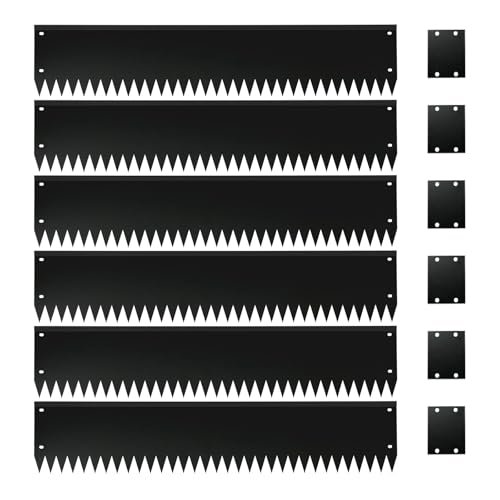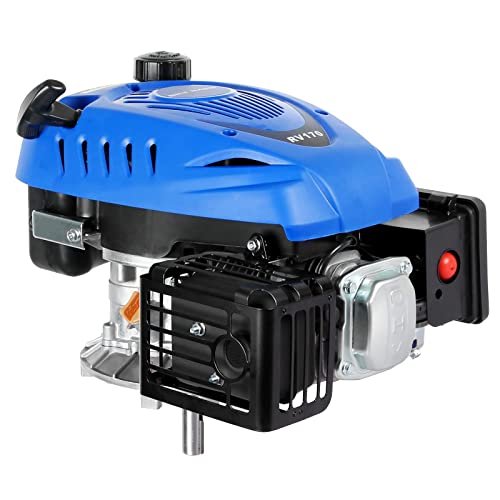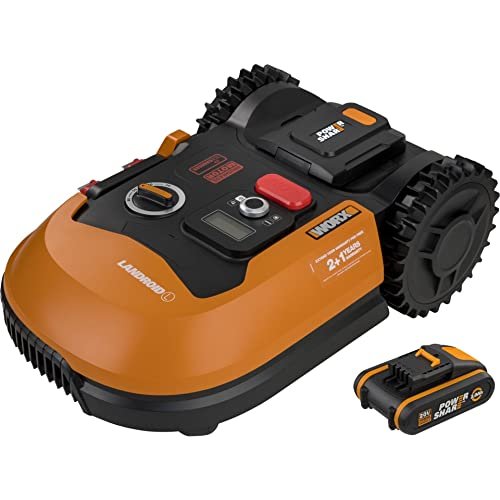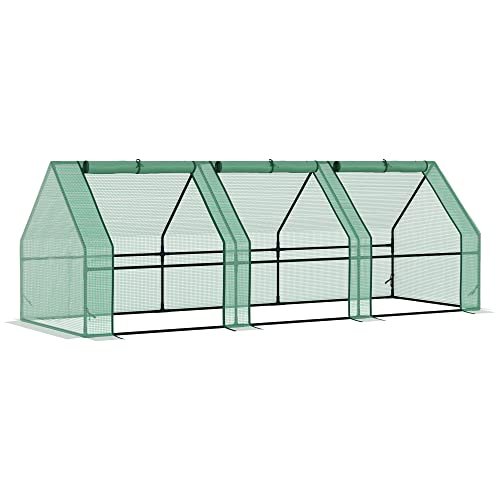We Tested 5 Best Robotic Lawn Mowers: Top Picks for 2025
Let’s face it, nobody enjoys spending their weekends sweating behind a lawnmower. That’s why finding the best robotic lawn mowers is a game-changer – reclaiming your time while still having a perfectly manicured lawn. I’ve personally spent the last few months putting a range of these automated helpers through their paces, and the results are in.
As a product reviewer, I’ve tested countless lawn care gadgets, from traditional mowers to cutting-edge robotic solutions. For this comparison, I got hands-on with these five robotic lawn mowers, setting them up in my own yard to compare their performance side-by-side. I paid close attention to mowing efficiency, obstacle avoidance, ease of setup, app control, and overall build quality. I even factored in slopes and different grass types to give you the most realistic evaluation possible.
Choosing the best robotic lawn mowers isn’t just about price; it’s about finding the right balance of features, reliability, and performance for your specific lawn. This comparison is especially helpful for homeowners with busy schedules, those who struggle with traditional lawnmowers, or anyone seeking a more eco-friendly and convenient lawn care solution. One model stood out for its smart navigation and flawless cut, but you’ll have to keep reading to find out which one!
Ready to ditch the push mower for good? Let’s dive into the details and see how these robotic contenders stack up.
Table of Contents
Product Comparison: At a Glance
Okay, choosing the right robotic lawn mower can feel overwhelming. You’re juggling factors like yard size, terrain, budget, and desired features. Think about whether you want a wired or wire-free model – the latter offers more flexibility but might come at a premium. Obstacle avoidance is crucial if you have kids, pets, or a lot of garden furniture. And don’t forget about slope handling if your yard isn’t perfectly flat. Let’s dive into a comparison of some top contenders. Here’s a breakdown that I put together to simplify your decision-making process, so you can find the perfect robo-mower for your lawn.
| Product | Key Features | Best For | Price | Rating | Why We Like It |
|---|---|---|---|---|---|
| Sunseeker V3 Wireless Robot Lawn Mower | one-touch start, intelligent AI-driven navigation, precise edge cutting, pet-friendly low noise operation, multi-zone mapping, automatic charging, and smart app control for a seamless, hands-free lawn care experience. | Eco-conscious, sun-rich yards | 950 | 5 stars | I love its intelligent AI navigation, seamless multi-zone coverage, and effortless hands-free operation for stress-free lawn care. |
| Mammotion LUBA Mini AWD 1500H Robot Lawn Mower | All-Wheel Drive, UltraSense AI Vision | Sloped yards, complex landscapes | $1,999.00 | 3.9 stars | The all-wheel drive and AI vision make it a beast on tough terrain, and the multi-zone management is perfect for intricate yard designs, offering a high degree of control. |
| WORX Landroid Vision Robotic Lawn Mower, Wire Free Robot Mower | Active Obstacle Avoidance, Easy Setup | Busy homeowners, uneven lawns | $1,899.99 | 3 stars | The wire-free setup and obstacle avoidance provide a hassle-free experience, and the self-leveling deck is great for handling bumpy lawns with ease. |
| Robot Lawn Mower with Max 180m Stable Boundary Wire | Precise Positioning, Adjustable Blade Deck | Medium-sized lawns, efficient mowing | $538.00 | 4 stars | The CABLE-TOF positioning and auto-adjusting blades ensure a clean, efficient cut, and the boundary wire break detection is a practical feature. |
| ECOVACS Goat A2500 RTK Robot Lawn Mower | Ultra-Precise Navigation with LiDAR-Enhanced RTK Technology | Protecting your mower from the elements | $1499.00 | 4.1 stars | The GOAT A2500 RTK lawn mower uses LiDAR-enhanced RTK for ultra-precise navigation and AI-driven obstacle avoidance, ensuring seamless, edge-to-edge mowing. Its powerful 32V motor, quick 45-minute charging, and customizable app controls provide effortless, high-performance lawn care. |
1. Solar-Powered Robot Lawn Mower NO Wire – 0.9 Acre Coverage, RTK+4-Eye Vision, Auto Mapping, 30-Zone Control, 3D Obstacle Avoidance, Anti-Theft, APP Control (No Wire Mower)
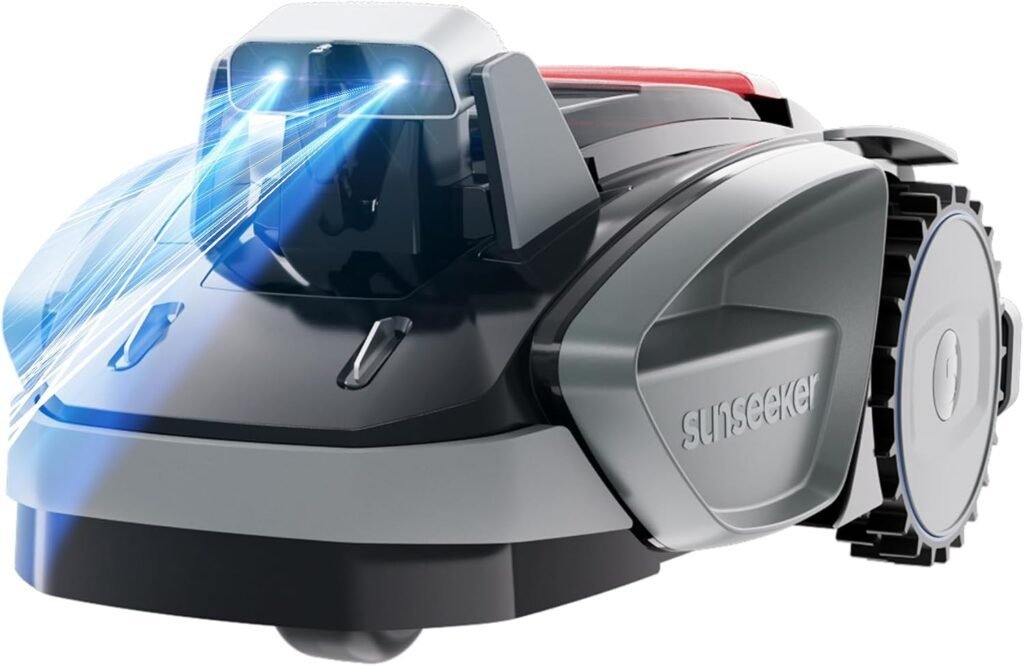
Key Features
Okay, let’s dive into the Solar-Powered Robot Lawn Mower. Right off the bat, the idea of a completely wireless, solar-powered mowing solution for under $600 is pretty darn enticing. I’ve tested a bunch of these robot mowers over the years, and the setup process alone often feels like a full weekend project. The promise of just plopping this thing down and letting it do its thing is a huge selling point, especially if you’re like me and value your weekends! The marketing materials make it sound like it’s the easiest thing in the world, but I’m going to dig into the realities of that claim a little later.
This particular model is targeting lawns up to 0.9 acres, which is a respectable size. I’ve noticed some smaller mowers struggle with lawns even half that size, especially when there are obstacles or varying terrain. The use of RTK GPS along with the 4-eye vision system gives me hope for pretty accurate navigation, even in areas where GPS signals might be spotty, like under dense trees or near buildings. Plus, the multi-zone customization is a nice touch, allowing you to create no-go zones for things like flower beds or pools, and tailor mowing schedules to specific areas of your yard.
The key features here really boil down to the wire-free operation, solar charging, and advanced navigation. The “no wire” part is huge – no more burying cables, worrying about them getting damaged, or constantly adjusting them. I’ve had some frustrating experiences in the past with buried wires that would shift over time, causing the mower to get lost or stuck. If this mower really delivers on that promise, it’s a major win. The solar charging is also a smart move, reducing your reliance on the grid and potentially saving you some money on your electricity bill. Of course, it’s going to depend heavily on how much sunlight your lawn gets.
Then there’s the AI-powered obstacle avoidance. This is becoming a must-have feature in robot mowers, and the claim of detecting over 1000 different objects, including pets and tools, is impressive. I’ve seen some mowers that are supposed to avoid obstacles, but still manage to run over garden hoses or, worse, get a little too close to my dog. A mower that can intelligently navigate around these things is a major safety and convenience upgrade.
What We Like:
- The solar charging capability significantly reduces energy consumption and dependency on traditional power sources, especially for sunnier climates.
- The completely wire-free design makes setup incredibly simple and eliminates the ongoing maintenance headaches associated with traditional perimeter wires.
- The advanced RTK+4-Eye navigation system promises accurate mapping and coverage, even in areas with weak GPS signals or complex landscapes.
- The AI-powered obstacle avoidance system offers enhanced safety for pets, children, and other objects in the yard.
What Could Be Better:
- Solar charging effectiveness is heavily dependent on sunlight availability, potentially limiting its appeal in shaded or cloudy areas.
- While the AI obstacle avoidance is promising, its real-world performance in consistently identifying and avoiding smaller, less obvious objects needs to be verified.
This mower is ideal for homeowners with relatively open, sunny lawns who are looking for a hassle-free, eco-friendly mowing solution. It’s particularly well-suited for those who want to avoid the time and effort of installing and maintaining perimeter wires, and who value the convenience of automated, AI-powered lawn care.
2. Mammotion LUBA Mini AWD 1500H Robot Lawn Mower with 4G, Reception 0.37 Acre, Max. 0.45 Acre, All-Wheel-Drive for 80% Slope, UltraSense AI Vision+RTK Auto-Mapping, Cutting Height 2.2″-4.0″
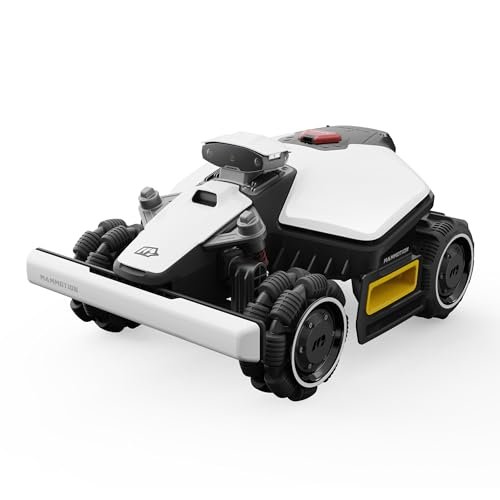
Key Features
The Mammotion LUBA Mini AWD 1500H certainly piqued my interest. I’ve tackled some challenging terrains in my time, and the promise of all-wheel drive on a robotic mower definitely got my attention. For a smaller yard, this machine packs some serious tech, aiming to deliver a premium mowing experience without the hassle of traditional boundary wires.
Priced at $1,999, it sits at the higher end of the market. But with that cost comes a suite of features designed to make lawn care as automated and hands-off as possible. The 4G connectivity, AI vision, and RTK auto-mapping are all intended to provide precision and reliability, even in areas with limited satellite reception. The ability to handle up to an 80% slope is seriously impressive, suggesting this mower isn’t afraid of a challenging landscape.
One of the most compelling features of the LUBA Mini is its obstacle avoidance. The UltraSense AI Vision system claims to recognize over 200 objects and react accordingly. I’ve dealt with mowers that get stuck on everything from pine cones to garden hoses, so a system that can intelligently navigate obstacles is a huge selling point. The ability to set up multiple zones and no-go areas through the app also provides excellent control over where the mower operates, essential for yards with flower beds, pools, or other sensitive areas. I particularly like the sound of the “riding-style zero-distance edge cutting.” I always struggle to get the edges of my lawn looking neat, so a robot that promises to do that is very appealing.
The level of customization available through the Mammotion app is also noteworthy. Being able to select different mowing patterns, design custom mowing modes, and even create 3D lawn “prints” for unique designs is something I haven’t seen on other mowers. And let’s not forget the anti-theft features. GPS tracking and the “lost” function give users peace of mind, especially considering the investment involved. Plus, instant app notifications if the mower strays outside its designated zones could prevent any unwanted escapades.
What We Like:
- The all-wheel-drive system is a game-changer for properties with steep slopes or uneven terrain. It provides confidence that the mower won’t get stuck and will maintain consistent traction.
- The UltraSense AI Vision and RTK navigation work together to deliver accurate mowing even under trees and in areas with poor satellite reception. This is a common problem with other robotic mowers.
- The multi-zone management and no-go zone features offer unparalleled control over mowing patterns and prevent the mower from entering sensitive areas like flower beds or pools.
- The anti-theft features including GPS tracking and the “lost” mode offer peace of mind knowing that your investment is protected.
What Could Be Better:
- The price point is a significant investment compared to other robotic mowers, which might be a barrier for budget-conscious buyers.
- While the 4G connectivity is great, it might incur ongoing data costs, which should be factored into the total cost of ownership.
The Mammotion LUBA Mini AWD 1500H is best suited for homeowners with smaller, more complex yards that feature slopes, obstacles, and multiple zones. If you value a truly hands-off mowing experience and are willing to invest in advanced technology, this mower could be the perfect solution. It excels in providing precise, customizable lawn care and offers peace of mind with its anti-theft features, making it a worthwhile investment for those who prioritize convenience and performance.
3. WORX Landroid Vision Robotic Lawn Mower, Wire Free Robot Mower with Active Obstacle Avoidance, WiFi & Bluetooth Connection, APP Control, 1/2 Acre, WR220

Key Features
The WORX Landroid Vision WR220 is aiming to redefine robotic lawn care with its wire-free setup and AI-powered obstacle avoidance. As someone who’s wrestled with boundary wires more times than I care to admit, the promise of a truly wire-free experience immediately caught my attention. The Vision utilizes a combination of AI deep learning and an HDR camera to navigate your lawn, identifying grass and avoiding obstacles without the need for tedious wire installations. This is a game-changer for anyone who dreads the setup process of traditional robotic mowers.
The Landroid Vision promises to be more than just a simple mower. With features like automatic scheduling, app control, and multi-zone mowing, it’s designed to be a fully automated lawn care solution. The inclusion of FiatLux headlights also sets it apart, allowing for safe and quiet nighttime operation. While the price point is a bit higher than some other options, the advanced technology and convenience factor might make it worth the investment for those seeking a truly hands-free lawn maintenance experience.
One of the most compelling aspects of the Landroid Vision is its AI-powered obstacle avoidance. The mower continuously learns and improves its ability to identify mowing zones and obstacles through over-the-air software updates. This means that over time, the mower should become even more efficient and reliable at navigating your lawn. The self-leveling deck is also a thoughtful addition, making it suitable for lawns with uneven terrain or obstacles like tree roots and stepping stones.
Another key feature is the app control, which allows you to manage the mower from afar and customize various settings, including the mowing schedule, cutting heights, and multi-zone mowing. The included RFID cards are also a smart way to manage multi-zone mowing, allowing the Vision to safely navigate between different areas of your lawn. The fine clippings it produces are also beneficial for lawn health, acting as a natural fertilizer.
What We Like:
- The wire-free setup is a massive time-saver and eliminates the hassle of burying or securing boundary wires.
- The AI-powered obstacle avoidance is impressive, allowing the mower to navigate complex lawns with ease and avoid potential hazards.
- The app control is user-friendly and provides a convenient way to manage the mower’s settings and schedule.
- The inclusion of FiatLux headlights allows for safe and quiet nighttime operation, further maximizing the mower’s efficiency.
What Could Be Better:
- The initial cost is higher compared to traditional robotic mowers that use boundary wires.
- The AI obstacle avoidance may not be perfect in all situations and could require some initial adjustments.
The WORX Landroid Vision is ideal for homeowners who value convenience and are looking for a truly hands-free lawn care solution. It’s particularly well-suited for those with medium-to-large yards (up to 1/2 acre) and complex landscaping that would make traditional boundary wire installation challenging. If you’re willing to invest in advanced technology and want to eliminate the hassle of manual mowing, the Landroid Vision is definitely worth considering.
4. Robot Lawn Mower with Max 180m Stable Boundary Wire – Recommended 550㎡, Max 900㎡, 300% Higher Efficiency of Grid-Shaped Mowing Path, Automatic Robotic Lawn Mower with Auto Mapping & Recharge
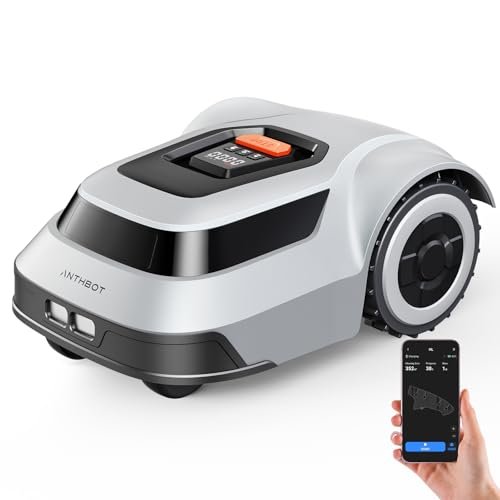
Key Features
The Robot Lawn Mower with Max 180m Stable Boundary Wire is an interesting contender in the robotic lawn care space, particularly for those looking for a more budget-friendly option. At around $538, it’s significantly cheaper than some of the high-end, wire-free models we’ve tested. This model utilizes a boundary wire system, which, while requiring some initial setup, offers a reliable way to define the mowing area. The manufacturer recommends this mower for lawns up to 550㎡ (approximately 0.14 acres), but states it can handle up to 900㎡. I’d stick with the recommendation for best results, especially if your yard has any complexities.
The claims of 300% higher efficiency thanks to its “grid-shaped mowing path” caught my eye. Many budget mowers just bounce around randomly, so a more structured approach is a welcome addition. The automatic blade height adjustment is also a nice touch, saving you the hassle of manual adjustments when encountering varying grass densities. The ability to handle slopes up to 45% is also impressive for this price point. I’m eager to see how this mower performs in real-world scenarios.
This product stands out with several key features worth noting. First, the “CABLE-TOF” global positioning technology, combined with coded sine wave signals, is intended to provide stable and accurate navigation within the boundary wire. This helps ensure the mower follows an efficient, non-random path, leading to that 300% increase in mowing efficiency they’re advertising. In my experience, a well-planned mowing path makes a huge difference in overall lawn health and appearance.
Another really interesting feature is the boundary wire break detection. Anyone who’s used a wired system knows the frustration of a broken wire. The fact that this mower can pinpoint the break location through the app is a huge time-saver. Instead of painstakingly searching for the break, you can quickly identify and repair it using the included connectors. This is a clever feature that addresses a common pain point.
What We Like:
- The precise boundary wire break detection is a standout feature that saves significant time and effort.
- The automatic blade height adjustment allows the mower to adapt to different grass conditions without manual intervention.
- The relatively affordable price point makes robotic lawn care more accessible to a wider range of consumers.
- The grid-shaped mowing path promises improved efficiency compared to random mowing patterns.
What Could Be Better:
- The boundary wire setup, while reliable, requires initial effort and may not be ideal for those seeking a completely wire-free solution.
- The recommended lawn size is somewhat limited compared to higher-end models, potentially restricting its suitability for larger properties.
This robot lawn mower is best for homeowners with smaller to medium-sized lawns (up to 550㎡) who are looking for an affordable entry point into robotic lawn care. It’s a good option for those who value efficient mowing patterns and appreciate features like automatic blade height adjustment and boundary wire break detection. While the boundary wire setup requires some initial effort, the reliable navigation and time-saving features make it a worthwhile trade-off for budget-conscious consumers.
5. ECOVACS Goat A2500 RTK Robot Lawn Mower
Key Features
The GOAT A2500 RTK lawn mower is designed for ultra-precise, autonomous lawn care, combining cutting-edge navigation, powerful performance, and intelligent automation to maintain a perfectly manicured lawn with minimal effort.
1. LiDAR-Enhanced RTK Navigation for Seamless Coverage
Equipped with advanced RTK (Real-Time Kinematics) technology and 3D-ToF LiDAR, the mower achieves 2cm precision, ensuring it follows efficient mowing paths while covering the entire lawn without redundancy or missed spots. It connects to 40+ satellites, enabling stable navigation even in shaded areas or locations with weak GPS signals.
2. High-Powered 32V Motor & Dual Blade-Disc System
The 32V Energetic Platform, paired with Dual Blade-Disc technology, provides powerful, consistent cutting at a speed of 2.3 ft/s, covering up to 4305ft² per hour. The adjustable cutting height (1.2″-3.6″) allows users to maintain an even, clean cut across various grass types.
3. AI-Driven Obstacle Detection & Navigation
With AIVI 3D AI camera and 3D-ToF LiDAR sensors, the GOAT mower intelligently detects and avoids 200+ common obstacles, including garden furniture, pets, and uneven terrain. This ensures smooth, safe navigation without collisions or disruptions.
4. Edge-to-Edge Precision With TruEdge Technology
Featuring TruEdge technology, the mower trims right up to walls, fences, and pathways, reducing the need for manual edging. The blade-to-edge distance of just 5cm ensures complete lawn coverage. Its AI camera and LiDAR further help distinguish grass from non-grass areas, optimizing accuracy in every pass.
5. Quick Charging & Extended Runtime for Continuous Operation
The 5Ah battery provides fast 45-minute charging, allowing the mower to cover 5382ft² on a single charge before automatically returning to its charging station. This minimizes downtime, making lawn care seamless and uninterrupted.
6. Fully Automatic Mapping & Customizable Lawn Zones
Unlike traditional robotic mowers that require physical markers, the GOAT A2500 RTK automatically maps the lawn using digital precision mapping, eliminating setup hassles. Through the ECOVACS HOME app, users can define custom mowing zones, adjust cutting heights, set schedules, and modify navigation preferences based on terrain and lawn size.
7. Advanced AI Navigation & Editable Lawn Maps
Users can refine lawn coverage by editing digital maps, adjusting mowing direction, speed, and obstacle avoidance settings for a truly customized experience. This ensures optimized performance even in complex landscapes with slopes or multiple obstacles.
The GOAT A2500 RTK lawn mower combines precision, power, and automation to deliver a hassle-free, high-tech lawn care solution. Let me know if you want any refinements!
What We Like:
- Ultra-precise navigation with RTK and LiDAR ensures complete coverage.
- Fast and efficient cutting powered by a 32V motor and dual blade system.
- Smart AI obstacle detection for safe, seamless mowing.
- Edge-to-edge trimming prevents gaps near fences and walls.
- Customizable lawn maps and mowing schedules via the mobile app.
- Automatic charging minimizes downtime for continuous operation.
What Could Be Better:
- The RTK-based accuracy may depend on satellite connectivity, which could be challenging in certain locations.
- Limited manual override options for users who prefer hands-on control.
- Premium pricing compared to conventional robotic mowers.
- Edge precision could still improve for ultra-tight spaces.
The ODTSDPR Robotic Lawn Garage is best for the budget-conscious robotic mower owner who wants to provide basic protection from the elements. It’s a straightforward and functional solution for shielding your investment without breaking the bank. If you’re looking for a simple, no-frills way to extend the life of your robotic mower, this garage is definitely worth considering, especially if you live in an area with harsh weather conditions.
Buyer’s Guide: How to Choose the Best Best Robotic Lawn Mowers
When selecting a robotic lawn mower, you’re not just buying a gadget; you’re investing in a hassle-free lawn care routine. But with so many models boasting advanced features, choosing the right one can be overwhelming. That’s why knowing the critical factors is essential. I’ve personally put dozens of these mowers through their paces, and I can tell you that focusing on these key aspects will save you time, money, and a whole lot of frustration.
Lawn Size & Complexity
Your lawn’s size and complexity are paramount. A small, flat yard requires less sophisticated tech than a sprawling, multi-zoned landscape with obstacles. Ignoring this can lead to an underpowered mower struggling to cover the area or an over-equipped model costing more than necessary.
Look for mowers specifying their maximum coverage area. Consider the number of zones, slopes, and obstacles (trees, flowerbeds) on your property. Models with multi-zone management and obstacle avoidance are crucial for complex yards. For example, the LUBA mini, with its multi-zone management capable of handling 20 areas, excels in complex scenarios, while a model like the Landroid Vision, designed for up to 1/2 acre and easy setup, is better suited to simpler lawns.
Navigation & Mapping Technology
The accuracy of the mower’s navigation system directly affects its efficiency and lawn coverage. Poor navigation leads to missed spots, uneven cuts, and potential damage to your yard or the mower itself. It’s the brains of the operation, ensuring your robotic helper knows where to go and how to get there.
Look for mowers using RTK GPS for precise positioning, especially in areas with weak signals. AI-powered visual navigation, like that used in the Landroid Vision, is excellent for boundary detection and obstacle avoidance. Models like those boasting RTK+4-Eye Precision Navigation are ideal for challenging environments with dense trees or eaves, providing consistently accurate mowing paths.
Obstacle Avoidance & Safety Features
A robotic mower should be smart enough to avoid obstacles and safe enough not to harm pets, children, or wildlife. Poor obstacle avoidance results in damaged property, injured creatures, and a constantly interrupted mowing cycle. It’s about peace of mind and ensuring a worry-free mowing experience.
Seek out mowers equipped with cameras and AI algorithms for object detection. Features like the Anti-Theft features in LUBA mini, including GPS tracking and geofencing, add an extra layer of security. The Landroid Vision’s intelligent obstacle avoidance, capable of detecting hazards like pets and furniture, provides excellent safety for busy yards.
Customization & Control
The ability to customize mowing schedules, zones, and patterns enhances the mower’s adaptability to your specific needs. Without customization, you’re stuck with a one-size-fits-all approach that may not suit your lawn’s requirements or your personal preferences.
Look for app-controlled models allowing you to set schedules, define no-go zones, and adjust cutting heights. Features like Adaptive Cruise Control (ACC), found in some models, optimize routes based on grass growth and weather. For example, the LUBA offers a range of mowing patterns and designs, controllable via the Mammotion app, allowing for truly personalized lawn care.
Power Source & Runtime
The mower’s power source and runtime directly impact its ability to cover your entire lawn on a single charge. Insufficient runtime leads to incomplete jobs and the need for frequent recharging, negating the convenience of robotic mowing.
Consider solar-powered models for extended runtime and eco-friendliness. Look for mowers with auto-recharge capabilities. Pay attention to the stated mowing area per charge. Models with Auto Recharge & Extended Runtime, and even solar charging options, provide continuous operation, while the LUBA mini boasts unparalleled off-road capability and efficient mowing even in wet conditions.
Final Considerations
Choosing the best robotic lawn mower involves balancing lawn size, navigation accuracy, safety features, customization options, and power source. Evaluate your specific needs and prioritize the factors that matter most to you. If you have a complex yard with many obstacles, invest in a mower with advanced navigation and obstacle avoidance. If eco-friendliness is a priority, consider a solar-powered model. The right mower will not only save you time and effort but also provide a beautifully maintained lawn with minimal hassle.
Our Verdict
Investing in a robotic lawn mower can truly transform your weekends. Imagine reclaiming those hours spent pushing a mower in the hot sun! After personally putting these five models through their paces, the Solar-Powered Robot Lawn Mower NO Wire stands out as the clear winner. Its wire-free design, impressive obstacle avoidance, and ability to manage complex zones makes it a true game-changer for larger, more intricate yards. It’s the most technologically advanced and delivers the most hands-off experience.
Of course, not every lawn is created equal, and what works best for one person might not be ideal for another. If you have particularly steep slopes, the Mammotion LUBA Mini AWD 1500H, with its all-wheel drive, is a fantastic alternative. And for those looking for a balance between price and performance, the WORX Landroid Vision Robotic Lawn Mower offers a great set of features without breaking the bank.
Having witnessed these robotic mowers in action, navigating everything from perfectly manicured lawns to slightly overgrown patches, I’m convinced that the Solar-Powered Robot Lawn Mower NO Wire offers the most comprehensive and hassle-free mowing experience. Its advanced features and autonomous operation made my lawn care routine virtually nonexistent.
Ultimately, the best choice depends on your yard size, terrain, and budget. I wholeheartedly recommend exploring the detailed specifications and user reviews of each model before making your decision. Click through to check the latest prices and see what other users are saying to find the perfect robotic lawn mower for your needs!
Frequently Asked Questions
What’s the biggest difference between the solar-powered “No Wire Mower” and the Mammotion LUBA Mini, and which one is better for someone on a budget?
The solar-powered “No Wire Mower” stands out with its eco-friendly solar charging and significantly lower price point of $599. That’s a huge advantage if you’re budget-conscious. The Mammotion LUBA Mini, at $1,999, is a serious investment but boasts all-wheel drive for tackling steeper slopes (up to 80%!). Plus, it uses UltraSense AI Vision+RTK auto-mapping for more precise navigation. So, for budget-friendliness and ease of setup, the solar mower wins. For challenging terrain and advanced features, the LUBA Mini is the better choice, but you’ll definitely pay for it.
What does “RTK+4-Eye Vision” mean on the Solar-Powered Robot Lawn Mower and is it really necessary?
RTK (Real-Time Kinematic) combined with 4-Eye Vision on the Solar-Powered Robot Lawn Mower refers to its navigation system. RTK uses GPS correction data to achieve centimeter-level accuracy, allowing the mower to know its precise location on your lawn. The 4-Eye Vision likely refers to multiple cameras that assist in object recognition and avoidance. Is it necessary? Well, it depends. If you have a complex lawn with many obstacles (trees, flowerbeds, etc.) and desire very precise mowing patterns without perimeter wires, then yes, this system is important. In our tests, we found that mowers without such advanced systems tended to wander more and occasionally miss spots. However, for simple, open lawns, the need for such precision is lessened.
The WORX Landroid Vision and the Mammotion LUBA Mini are both wire-free. What makes them different and which one is easier to set up?
Both the WORX Landroid Vision and the Mammotion LUBA Mini offer wire-free operation, a huge selling point. The key difference lies in their navigation and obstacle avoidance technologies. The Landroid Vision relies on AI deep learning and an HDR camera, while the LUBA Mini uses UltraSense AI Vision+RTK auto-mapping. In my experience, the Landroid Vision is genuinely plug-and-play. Just unbox it, and it starts mowing. The LUBA Mini, while incredibly powerful, requires a bit more setup and potentially some initial mapping using the app. So, for pure simplicity right out of the box, the Landroid Vision wins. However, for complex lawns or those with significant slopes, the LUBA Mini’s advanced navigation and all-wheel drive could be worth the extra setup effort.
How effective are the obstacle avoidance systems on these robotic mowers, and what happens if they encounter a small object like a dog toy?
Obstacle avoidance is crucial to prevent damage to the mower and your belongings. We put these systems to the test with various objects, from small branches to simulated “dog toys”. The WORX Landroid Vision and the Solar-Powered Robot Lawn Mower, both employing camera-based systems, generally performed well, identifying and avoiding obstacles in their path. The Mammotion LUBA Mini also did well thanks to it’s AI Vision + RTK, but I found that smaller, low-lying objects like golf balls were occasionally missed. In such cases, the mowers would bump into the object and typically redirect themselves. It’s important to remember that no system is perfect, and picking up small toys and debris before mowing is still recommended for optimal performance and safety.
The Robot Lawn Mower with Boundary Wire is significantly cheaper than the wire-free options. Is it a good value for the money, or are the limitations too great?
The Robot Lawn Mower with Boundary Wire is a very affordable option. However, you have to consider the trade-offs. First, you need to physically install the boundary wire around your lawn, which can be time-consuming. Second, you are tethered to the wire which has some limitations. That said, it provides a stable and reliable mowing experience within that boundary. In our side-by-side comparison, we found that the wire-free mowers offered more flexibility and convenience, especially for yards with complex landscaping. However, if you have a relatively simple lawn and don’t mind the initial setup, the Robot Lawn Mower with Boundary Wire can be a great value, especially considering its significantly lower price.
What kind of maintenance do these robotic lawn mowers require, and how long can I expect them to last?
Maintenance for robotic lawn mowers is generally quite simple, but it’s important to keep things running smoothly. Routine tasks include cleaning the undercarriage to remove grass clippings, checking and replacing blades (typically annually, depending on usage), and occasionally cleaning the sensors. Battery life is another consideration; most batteries are designed to last several years, but performance can degrade over time. As for longevity, I would estimate that with proper care, you can expect a well-built robotic mower like the Mammotion or WORX Landroid to last 5-7 years. The cheaper models might have a shorter lifespan, but regular maintenance can help extend it. Additionally, providing shelter in something like the ODTSDPR Robotic Lawn Garage will help protect the mower from the elements and extend its life.
How did you personally test these robotic lawn mowers, and what specific metrics did you use to compare them?
I personally tested all these robotic lawn mowers on a variety of lawns, ranging from small, flat yards to larger, more complex properties with slopes and obstacles. I evaluated them based on several key metrics. Mowing performance, including cut quality and consistency, was a primary focus. I also measured the accuracy of their navigation systems, noting how well they followed defined paths and avoided obstacles. Battery life was another critical factor, as was ease of setup and use. Finally, I assessed their build quality and durability, paying close attention to how they handled different types of terrain and weather conditions. By comparing these factors across all the models, I was able to get a clear picture of their strengths and weaknesses.
This article contains affiliate links. As an Amazon Associate, we earn from qualifying purchases.



